By ZOE VALERY
This woman in the airport is neither catching a plane nor meeting one. (…)
Why is this woman in this airport? Why is she going nowhere, where has she been?
—Joan Didion, “Why I Write” (1976)
In the margins of the Strip, planes shimmer in and out of Las Vegas. I photographed this periphery, populated by plane watchers. Why they watch and why I write seem to be connected by a tenuous link that became clearer as the afternoon transpired.
*
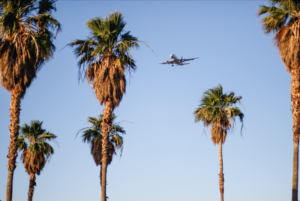
Sundown marks the time and the place for a discreet show among Las Vegas locals. At the golden hour, vehicles on Sunset Road veer toward McCarran International Airport and park in front of the runway. While the casino-jammed stretch of Las Vegas Boulevard known as the Strip blinks itself awake in the background, the airstrip stages a steady stream of landings and take-offs. Every day, new and seasoned plane watchers come here to view the aircrafts rolling between the sky and the Vegas skyline.
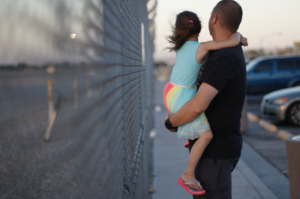



A week before, I had landed on the other side of the fence. But the reason for my trip had little to do with the city itself, or its Strip. I was visiting my friend Tete, who happened to be spending the summer here. We were both completing our MFAs in New York and writing our theses, of all places, in Las Vegas.
This was my first time in Vegas.
We had first noticed the planes outside the coffee shop where we had been writing—or, in my case, attempting to—earlier that afternoon. The bellies of the aircrafts overhead had seemed to brush the palm treetops in the parking lot. Tete dipped her head into the mirage of the car’s roof and we were soon driving along Sunset Road, parallel to the airport’s landing strip, chasing after the descending planes.



Like the Strip, the airstrip offers immediate gratification, but what locals seek here is a respite from the business of leisure. They come to watch machines at work. Machines that yield only a pound of rubber smeared on the pavement. And intervals of quiet.
When Balaji’s nephew comes to visit him in Vegas, he brings him to the runway viewing area. A comfortable silence sits between them as they wait, the red sunlight setting on their skins. The boy sees me approach and asks his uncle, audibly, to tell the girl—me—not to come so close to them. He feels very anxious around people, his uncle explains, and the planes calm him down. As we wait, I eye the Strip, imagining how he must feel amid its chaos. The boy throws his arms in the air at an approaching plane, as though controlling its gravitation.

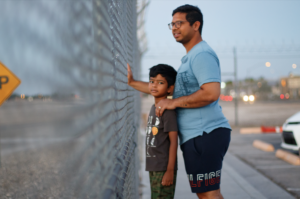
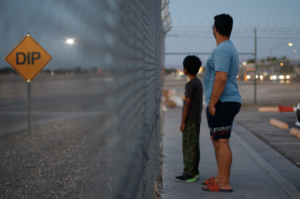



There is a sense of wonder, of happening; an air of suspense in the suspension of the planes. And in the landing, a marker of certainty, a daily expression of completion, a reminder of the clockworkness of the world. Things land as expected. Even when no one is expected. The planes deliver thrill and solace in this way.
Some plane watchers tune their radio to 101.1 FM, eavesdropping into the chat between the pilots and the control tower. The smooth, perfunctory exchange of the voices heightens the precision of the feat. Miles, minutes, knots, numbers are uttered with cordial ease—“thank you, have a great day.”
Even amid high winds and dust storms, the tower at McCarran Airport keeps the Vegas skies under control. Except on one occasion, in 2018, when an air traffic controller became unresponsive during a night shift and fell silent, leaving requests for take-offs and landings unanswered. During this hiatus, which lasted around half an hour, the planes taxied and hovered in the dark.
The air traffic control tower overlaps with the skyline of the Strip, where Giza pyramid, Ferris wheel, Eiffel Tower, the Empire State building rub shoulders nonchalantly. In the foreground, the planes parade on the runway, as if enacting the missing journeys between the disparate cohort of buildings. Perhaps it is up to the control tower to restore the space-time logic collapsed by the eclectic architecture of the Strip, a task so overwhelming that it might render an air traffic controller mute.
I’ve experienced the famed timelessness of Vegas in its Strip: that neck of an hourglass whose sands transit freely both ways, as empires and emporiums rise and sink back into the desert. I walked through its anachronisms, moving swiftly through its epochs, experiencing time as space—retail space—in Vegas. Inside its buildings, the same hour seems to hover in the air. The same hour that has landed, is about to land, will land. The same hour that has taken off, is about to take off, and will take off. Like the snapshot of an air queue. Time doesn’t fly in Vegas; it is suspended.
If one were an alien with little time to look around on this planet, one would perhaps choose to visit the microcosmos of Las Vegas—after discreetly parking the spaceship in the desert—to cut across the span of human experience through the peaks and troughs of the Strip.
The row of cars in the observation lot flashes a string of headlights against the fence of the runway. The side windows of the vehicles form a tunnel layered with profiles facing the flying objects. In the dimming sky, the planes arriving at McCarran turn into celestial bodies. Aligned in the aerial queue, they look like stars that are light-years apart.



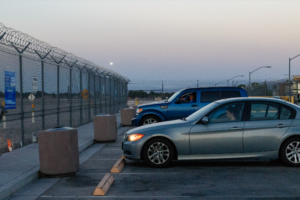
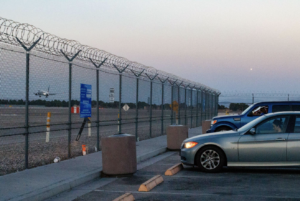
Alien to the city, I had been genuinely moved by the Strip: by its authentic replicas and inventive simulacra. I caught myself admiring the indoor skies painted on ceilings of the Venetian Hotel and remarking on the pink tinge of their artificial sunsets, which struck me as much as those on the gaping desert skies, shredded by contrails. Tete tells me that it is common for tourists from Venice to stay at the Venetian, and for Parisians to take selfies with the Eiffel Tower on the Strip. When we walked through “New York-New York,” we certainly dodged people with newfound urgency, picking up the pace we use in the real city.
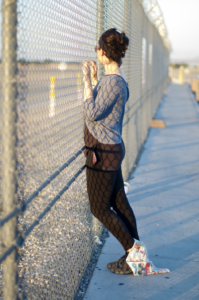
A local newspaper curls around Tete’s legs momentarily before continuing its bumpy flight in the parking lot. It doesn’t occur to anyone to unleash its aerodynamic potential with a few folds.
Hanging out with Tete comes, invariably, with an impending sense of adventure. Our friendship has developed across airports and borders, and is still largely based on improvised movement, on pliable plans. The day before my trip to Vegas, she told me to bring my passport. “Just in case.”
Alien to the country, I had to travel with my passport anyway. On the security line at JFK Airport, the official had pointed out the looming expiration date on my passport, which reads “Venezuela.” The Venezuelan consulate in the U.S. had been indefinitely shut since early 2019 after a break in diplomatic ties between the two governments. In response, the U.S. and other countries officially recognized the validity of the Venezuelan passport five years after its expiration date. Ironically, my expired passport would allow me to visit most countries, but not my own. If I were to go back to Venezuela, I would be, for the foreseeable future, stuck in a nation with scant resources to address the basic needs of its fleeing population, to say nothing of issuing passports. One can enter Venezuela with an expired passport, but even those with dual citizenship cannot leave the country until the document is renewed. “There’s no material,” is a standard bureaucratic reply. “There is no paper.” Not even to print the news. Banknotes of devalued currency are folded into paper planes.
As I asked myself if my plans to write about my hometown, Caracas—the basis of my MFA thesis project—had been grounded, the JFK customs officer handed me back my passport and let me through to my gate. For the time being, I was Vegas-bound—Vegabond, a vagabond. Through the plane window, I watched as the snow-capped mountains rapidly plunged into the desert basin, rising again in ranges, sinking into canyons. The antediluvian topography evolved with an almost artificial clarity, like a model textured and hand painted by a landscape architecture student. From the air, the Strip looked like an afterthought of the student, who had hastily gathered and lined up a bunch of miniature building souvenirs here, to the dismay of any sensible urban planning professor.
Yet, in 1968, architects Denise Scott Brown and Robert Venturi had brought their class to Las Vegas on a field trip precisely to admire and learn from the maligned Strip. The result of their unlikely excursion was Learning from Las Vegas (1972), a study of the Strip that redeemed symbolism in architecture, challenging the predominating Modernist aversion to ornamentation. The volume paved the way for a “fun” and “communicative” architectural style inspired by the commercial Strip: postmodernism.1
In the book, Las Vegas is presented as a city that makes itself legible through conspicuous building signs that compete for the attention of visitors. The authors note that signage is so prominent in the architecture of Vegas that buildings themselves have become signs; a point they illustrate with the example of a shop that sold duck products in a duck-shaped building. (These types of buildings, regardless of their specific function, have entered the architecture lexicon as “ducks.”)2 Scott Brown has mentioned that the buildings/signs of the mercurial city are frequently imploded to cater to tourism and make way for more profitable businesses: “The Strip is always reinventing itself, responding to what consumers want… People voted for Las Vegas with their feet.”3
The same year that Learning from Las Vegas appeared, a work that has become a referent of postmodernist literature was also published: Italo Calvino’s Invisible Cities (1972). Framed as a conversation between Kublai Khan and Marco Polo, the novel performs philosophical wanderings through a series of fictitious places with female names, arranged by categories such as “Cities & Memory,” and “Cities & Eyes.”
Calvino’s style lends itself to describing the implausible city of Las Vegas, populated with signs amid the silence of the deserts. Vegas would probably fall under several—or all—of his headings: “Cities & Desire” or “Cities & the Sky,” “Cities & Signs.”
Vegas is all cities at once and no city at all. All cities descend onto the airstrip, in the same way that all cities spring up in the Strip. Recreation here is twofold and perpetual. Visitors recreate in a city that is ever re-creating herself in the image of their cravings. Vegas devours currency from anywhere and excretes tokens that are worthless elsewhere—then again, Vega herself is made of tokens of elsewheres. The day she recreates herself in herself, Vegas will cash in, or she might become fractal and kaleidoscopic: a Strip within the Strip, infinite and eternal. The denizen of Vegas lives in all cities at once and no city at all.
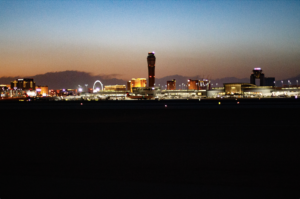

Aptly plural, the name “Vegas” (which, in Spanish, means “meadows”) contains the sum of all her versions. Even the seasoned visitor is always a newcomer to the latest Vega.
Vega I
One comes to this Vega to leave. But one leaves this Vega to return. One never departs feeling this was the right Vega. So there is always the next Vega. As the flight attendants roll their service cart up and down the aisle, the pilots cater to this perpetual thirst. Vega is reborn with each landing and dies again with each take off.
Vega II
Nothing is fixed in this Vega; only drinks. As fortunes turn in—and for—attractions on the Strip, the airport’s runways are reversed to keep up with the mood of the winds and the magnetic poles of the Earth.
The Strip keeps unfixing itself, now imploding with volcanic failure, now exploding with abysmal success.
Vega III
Vega has little water but many watering holes turned into wishing wells, which overflow with a global mishmash of coins. Vega pumps wishers to source her wells and her slots.
Vega IV
At first glance, the signs of Vega are perfectly legible. But, sometimes, by the time you reach the building you were going to, the letters of the sign have rearranged themselves, spelling out a different word. Other times, the building you are approaching morphs into a duck, and the duck quacks the word you had read on its original sign.
Vega V
Those grounded in Vega long for the sky. Those airborne over Vega long for the ground.
This Vega is already the next Vega. Her blueprint hovers in the blue sky. Impatiently, Vega’s skyline shimmers in the heat, as her new self begins its descent. The landing queue, a floating city. At 30,000 feet, around 200,000 new feet get ready to tread and retread the Strip.
Vega VI
Vega strips herself of herself and devours the Vega she has just shed. The outbound planes remove the dregs of the urban past, the ruins of a previous Vega.
Vega VII
Vega is the city of return.
One visits Vega seeking cities one has seen and leaves finding Vega in all the cities one will see. When a visitor departs, they are never quite sure if they have really left, or not; whether the points of departure and arrival have become the same. Their own city feels odd, no longer like home. As if they were still in Vega, where planes merely circle in the sky.
Vega VIII
Vega gazes back at you.
Vega tours you and describes you, flashing signs that form these words:
The city of “Zoe” is prone to iteration. Every avenue and every alley, every corner and every building has “x” number of versions. The Strips of Zoe lead inwards and outwards at the same time. When you think you are leaving the city, you only go deeper into it. When you think you are going deeper into it, you have already left.
In neon electrographics, Vega adds:
Vega—not you, not anyone—writes and rewrites herself.
Not you, who are fenced off by your own words, by your own skin.
Vega IX
Those who seek an oasis in Vega will only find a mirage. Those who think that Vega is but a mirage, will find a mirror, but won’t believe it real.
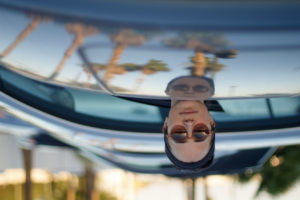
Vega X
Vega is blinding, but also blind to herself.
Only locals truly get to see Las Vegas. But, even to them, some Vegas remain invisible.
Nostalgia is palpable in the McCarran viewpoint: a deep, constant emotion that pervades the city, like a hum in a radio frequency, welling up occasionally.
Maddie hangs out at the observation deck on Saturdays. Clad with 4th of July bows, Hollywood peers through the window wagging her tail and offers me an easy way into a chat with Maddie, who has recently moved here, she tells me, from New York. She sighs when I mention that I’m visiting from there. Maddie says she loves Vegas and its vibrancy but also that, if she could, she would take the next flight back to New York City. I’m surprised to find this yearning peering through her wide smile and her sparkling personality, amid celebrations of personal and collective independence.


Maddie tells me she has never had a real place to call home, and that, despite her flying anxiety, she finds peace at airports, which transport her to other plane-watching moments in the past. Whenever she visits her family in Traverse City, Michigan, she sneaks off with her mother to get some McDonald’s and sit by the runway of the local airport to watch airplanes together.
Sitting in her neon blue pick-up with Hollywood by her side, Maddie sometimes calls her mom as she watches the planes. Perhaps her mom is facing a very similar sight back in Michigan. I imagine flights between Traverse City airport and McCarran, boarded and not boarded by Maddies and their moms.
According to Maddie, the airstrip opens up her perspective in different ways every time. “Depending on where you are at the deck, you will see something so different. Maybe you can see the take-offs better than the landings. Maybe you have an amazing view of the Strip with the sunset highlighting every building in front of it. Maybe you see a family waiting for a loved one’s plane to land and scurry to get their car started to get to the front of the airport. Maybe you’ll see a girl on the brink of tears with her dog and take a few pictures of the two of them that brighten her day a little more. It’s all about perspective.”


The overlap of airstrip and commercial strip opens up a space and a time to sit with our sense of displacement, of ontological homelessness. Also into view comes a filmstrip of places locked in the mind under “Cities & Memory”: cities invisible to others, but latent within.
I approach the next vehicle and am greeted by a mother and daughter. In the dimness of dusk, my camera struggles to capture the slushie-sipping pair, who take pity on my failed portraiture attempts and kindly turn on the dome light. As I fumble with the exposure settings, the woman tells me that her copilot is in fact nearing her seventeenth birthday and prompts the girl to let her hair loose. The photoshoot is foiled by their rocking bursts of laughter. I’m vaguely aware that I’m inside a future memory, another mother-daughter-plane-watching memory. Or maybe I’ve stepped into the past of a sixteen-year-old Maddie, getting teased by a mom all too aware of how fast her daughter is growing up.
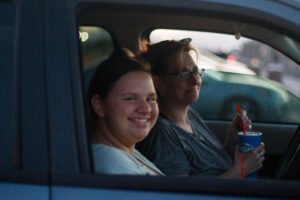




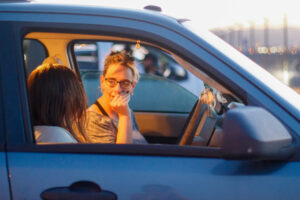


Meanwhile, the fence that the sunlight had erased becomes more evident as the evening progresses. The Strip glows through the wire diamonds. I meet a family from Acapulco who nod, without another word, when I ask if I can take pictures of them.

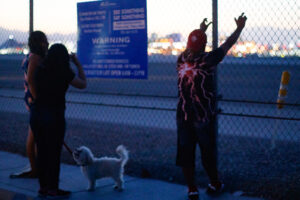
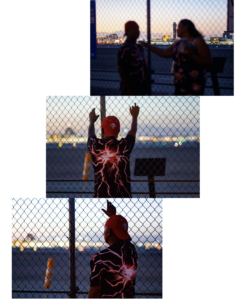

A scene of fences and defenses. Of silence and containment. Of something cracking the shell from within. And the moments when we drop our guard. Electrifying, his t-shirt suggests—the fence, the kiss.
As it grows darker, the headlamps highlight the loops of barbed wire and the warning signs that send back echoes of the southern border. Now and then, an airplane parades a sign that spells out “Frontier.”
The construction cranes spiking the skyline and the increase in air traffic at McCarran confirm that Vegas continues to be one of the fastest growing cities in the country. Several of the locals we encountered on our trip note this with excitement. I wonder if the plane watchers also feel an acceleration in the airport as the city’s pulse quickens; if the strips beat in unison.
“If you build it, they will come,” goes the Vegas longtime credo, which rings most true when a plane plunges into the silhouette of the craned Strip, fusing the verbs build and come in the visual sentence of the skyline.
But what about the people who are here, in a city whose intended audience is the tourist? Las Vegas prides itself on being an oasis for minorities and immigrants. Nevada’s increasingly diverse population has been deemed to reflect “the future face of America.”4 The most important changes are not happening in the ephemeral façades of Vegas, but in the faces settling in the city.
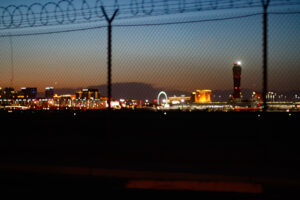

Earlier in the day, we had picked up Tete’s cousin, George, after his wisdom teeth surgery, from which he came out singing with a cotton-full mouth, high from the meds. George is a medical student in Vegas. The community rotation of his program has exposed him to the city’s underworld. In the sewage system of tunnels that run right underneath the Strip, he told us, there are more than 20,000 people suffering from some form or other of addiction: meth, heroine, slots, bets.
The dark, damp, underbelly of Vegas is home to gamblers who have spent decades under the casinos that ruined them; to addicts, and to people escaping drug traffickers, pimps, the police. Many women squeeze into holes in the tunnel walls to feel safe in their sleep.
Under the contrails and the tourist trails: the entrails of Vegas. Beneath the Venetian canals, a tangle of tunnels flooded with darkness, drains with the drained.
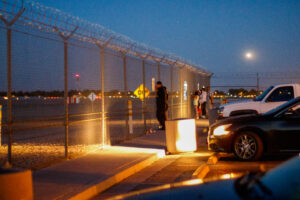

Tete and I are staying in a house within a gated community in the outskirts of Vegas. Most of the houses around us are empty. Las Vegas has ranked as one of the cities with the most house vacancies in the U.S. Vega is a city of empty homes and of sewers full of homeless people.
My hometown, Caracas, is also a city of empty houses. For those who stayed, these houses mark the tangible absence of the millions living in exile. Caracas looks like an underground city; even on the surface, even high up inside its skyscrapers. Abandoned houses, abandoned buildings. Darkness floods the streets now and then, erasing entire neighborhoods at night. Electricity and water shortages have led people to dig wells, seeking water underground. Those who remain in Caracas find themselves in a state of “insile”—the feeling of being exiled within their own homeland.
I never suffered this kind of thirst in Caracas. Even if I were able to go back, I wouldn’t be able to find the city I once knew. Caracas is also plural and different with each visit. Caraca. Caraca. Caraca. Caraca. Caraca es una ciudad de muchas caras. Caras cegadas. Caras mudas. Caras de hambre. Caras de sed. Caras borradas. Caras y casas vacías. Pero también caras que todavía ríen a carcajadas; carcajadas que suenan así: “Ca-ra-ca-ca-ra-ca!”
In the observation lot, my attempt at small talk in Spanish with the family from Acapulco rapidly dissolves into silence again. After leaving Venezuela, I had moved to Mexico; we—this family and I—are, on paper, the same: Mexican citizens, and probably have the same tendency to revive, under our breath, the lost phonetics of names like “Hacienda Avenue,” “Rancho Drive,” “Palos Verdes Street,” “Sierra Vista Drive.” With each Hispanicized utterance, we redraw, for a moment, the mid-nineteenth century border we learned to mourn in history class at school. For that instant, Mexico makes its way back.
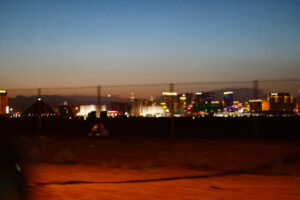
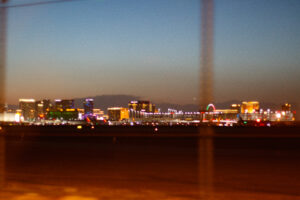

Tete and I also grapple with our individual and collective identities, which are marked by displacement, diaspora and movement. She, Armenian. I, Venezuelan. And not quite purely one or the other. We both exist in the creases of these malleable selves. On paper, we are, namely, an American and a Mexican. But on the page, we are free to fold and unfold our different facets and faces. Tete I. Tete II. Zoe V… VII…


Yet, the silence between the family and me reveals that we are far from akin, that there are tacit fences between us.
The sunset imprints the wires on our skins. So much of the real magic of this hour comes from, rather than the tired trope itself, the way the sunlight—and its absence—sets on surfaces. For a brief while, the plane watchers, Tete, and I are all wearing the pattern of the fence.
Chain-link fencing was, after all, an invention based on cloth weaving machines. The same wire that clad and cut up the American West, now dresses our bodies, signaling something about privacy, privation, deprivation, depravation. As if the Strip were casting light and shadows unto us, fleshing out our want for touch, for connection, and for the homes we project onto Vegas.
But wire also connects, conducts. The silence between the inbound and outbound planes also carries, like an unspoken understanding, an affinity for transience—a common trait in the lot. We plane watchers are always arriving at the places we have departed, which no city can strip from us. Places whose shadow grows more pronounced in light of new places. Places that delimit us from within.


Credit for these two images belongs to Taleen Mardirossian, a.k.a. Tete.
In Invisible Cities, Kublai Khan asks Marco Polo why he has described every city he knows except his own:
‘“Sire, I have told you about all the cities I know.”
“There is still one of which you never speak.”
Marco Polo bowed his head.
“Venice,” the Khan said.
Marco smiled. “What else do you believe I have been talking to you about?”
The emperor did not turn a hair. “And yet I have never heard you mention that name.”
And Polo said: “Every time I describe a city I am saying something about Venice.””
My passport, which I have learned to carry with me, in case we jump on one of these planes, reads in gold: Venezuela, which is said to mean “Little Venice.”
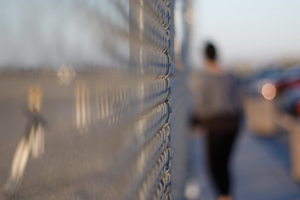
Zoe Valery is a writer whose work has appeared in The White Review, New England Review, Longreads, and elsewhere.
Footnotes
1 Postmodernism is characterized by performance, play, pastiche, parody, paradox, and a provocative probing of the “real.”
2 Perhaps the most cited takeaway from Learning from Las Vegas is the difference between a “duck” (a “building-becoming-sculpture” that acts as a sign, communicating its function through form) and a “decorated shed” (a nondescript building that uses signs to indicate its purpose).
3 Interview with Dennis Scott Brown for the podcast 99% Invisible.
4 https://www.usnews.com/news/best-states/articles/2017-08-30/nevadas-population-is-the-future-face-of-america




